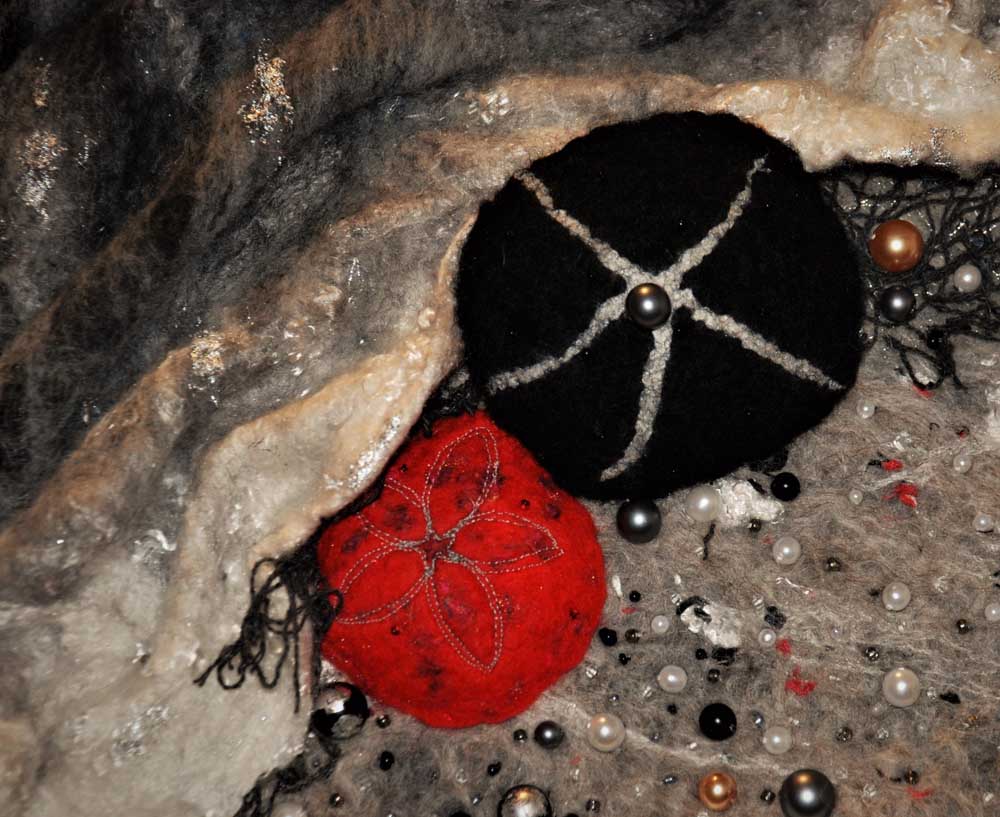Robin Montero shapes art according to her imagination
Published 6:54 am Monday, November 5, 2018

- A close-up of felted wool sand dollars on Robin Montero's “Atomic Beach” hanging shows their three-dimensional quality.
Poseidon awaits. His face is in profile, eyes focused ahead, his white hair flowing back in felted woolly waves, outlined against a black background.
“He’s my favorite,” said Seaside textile artist Robin Montero, who nods at the felted head of the mythological Greek god of the sea.
“He’s the one that told me I could do this,” she said. “He’s the one who gave me the confidence to keep going.”
The bas relief sculpture, along with several other of Montero’s wall hangings, all formed with felted wool, are on exhibit at the Cannon Beach History Center & Museum through November. She also has a show at SunRose Gallery in Seaside.
Her innovative pieces reflect Montero’s imagination, skill and experimentation with a variety of techniques.
Montero, a former professional theater costume designer, knows how to work with fabric, but she had never encountered felted wool until she “stumbled” across it while talking to a woman in a fabric shop. After reading some books, she thought, “I could do this.”
“When I discovered this, the very first thing I made was a sand dollar. And then I wanted to do something more dimensional. I thought, ‘Well I can draw faces, so why don’t we try a face?’ ”
Poseidon hooked her.
“There are so many things you can do with fiber,” Montero said.
Her wall hangings range from multi-hued ocean waves and beaches in blues, tans and whites covered in three-dimensional sand dollars, to delicate daisies and a geisha mermaid.
She uses a combination of needle felting and wet felting in her work. Needle felting is done by poking strands of wool fibers through fabric with a barbed needle; the barbs catch the fibers and lock them into the fabric.
Wet felted wool is created by layering strands of woolen fibers perpendicular to each other, soaking them with hot water, brushing those layers through a mesh screen until they are combined and rolling them in bubble wrap until the fibers are bonded into a material, that, after it is air dried, can be cut and shaped.
Then the fun begins. It’s up to Montero to decide what she wants to create and how to do that.
“This medium is wonderful because there are no rules, there are no limitations,” she said.
In the center of the felted wool waves of one her works, lying on the felted, beaded wool sand is a glass bottle with a message inside.
“My dearly beloved, I can’t wait to be with you again,” says the message, written in Italian. “Here is the key to my heart. I will always love you. Love, Georgio.”
“There is a key in the bottle,” Montero said. “It’s the skeleton key to my bathroom door.”
That piece took about 150 hours to create, including sewing individual beads to look like small rocks among the sand dollars, which took the most time.
“But every now and then when you catch the twinkle — that’s what it’s all about. It’s all about the details,” Montero said.
History center Director Elaine Trucke asked Montero to exhibit her work because “I am a huge fan of felting and what artists do with it. I was especially partial to the lamps that she created.”
Some of Montero’s work, including Poseidon and his wife, Amphitrite, look like Greek or Roman sculptures, Trucke said.
“But instead of cold stone you have soft and warm fabrics…. Her love of the sea, of historic art, and even her background in costume design. It’s just so different from what most people are doing with textile.”
But the details present challenges. When Montero knows what she wants to do, she usually develops her own technique — something that’s not found in a “how to” book.
In her felted sculpture of a geisha mermaid on display at the SunRose Gallery, she used a variety of methods and materials. Along with a purple velvet jacket, sewn of leftover costume material, the mermaid wears a skirt of sequined black, blue and green fabric. Her fins are layers of silk organza and metallic threads. The pearl necklace hanging from a hook beside her reflects Montero’s other interest in jewelry design. Entitled, “Proposal at Sea,” the piece has a felted wool and beaded background in blues and lavenders.
Always thinking of the next project, Montero keeps a notebook of ideas, where no boundaries restrict her creativity.
“There are no rules,” she said about her textiles. “That’s the best part.”





